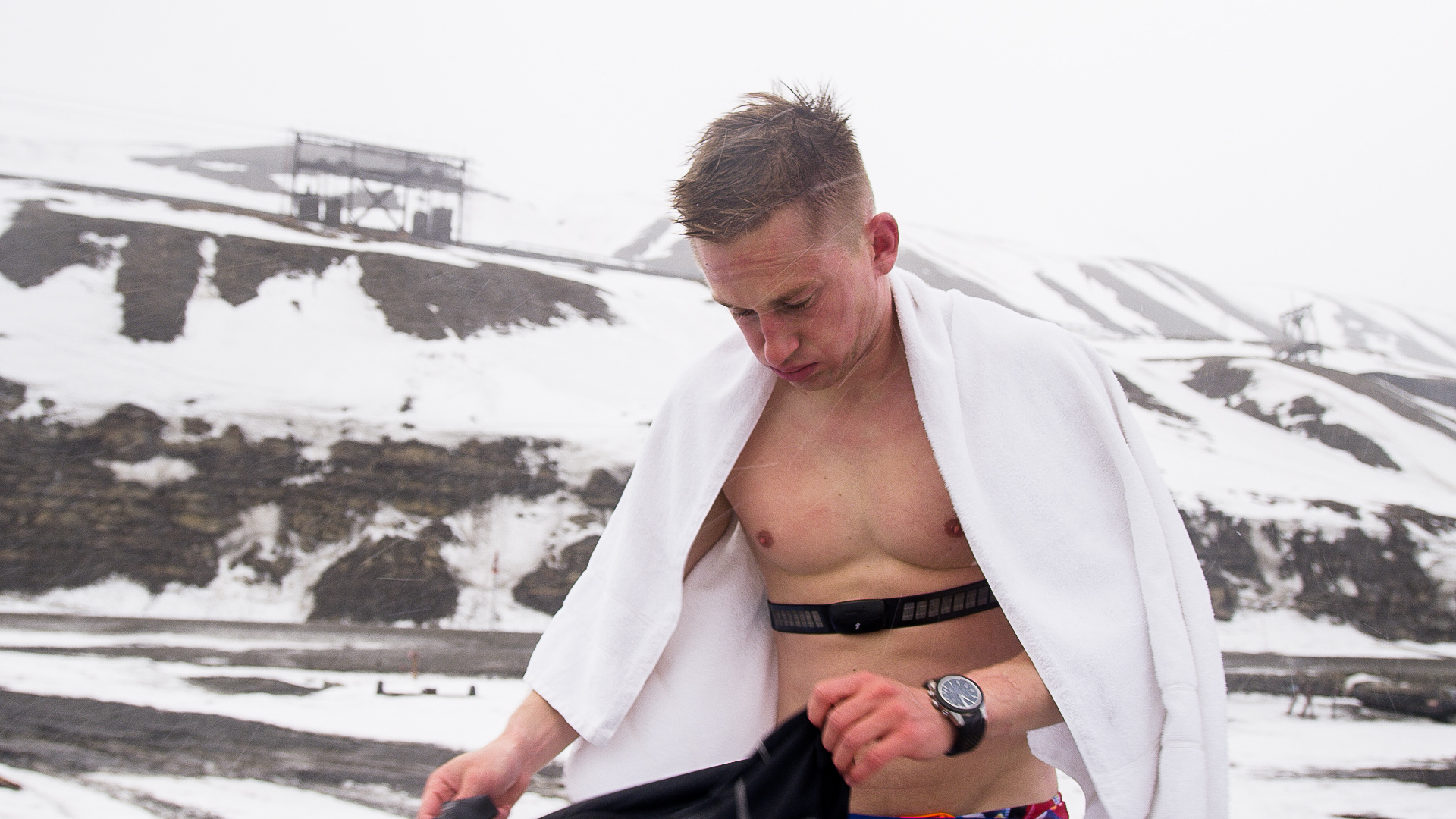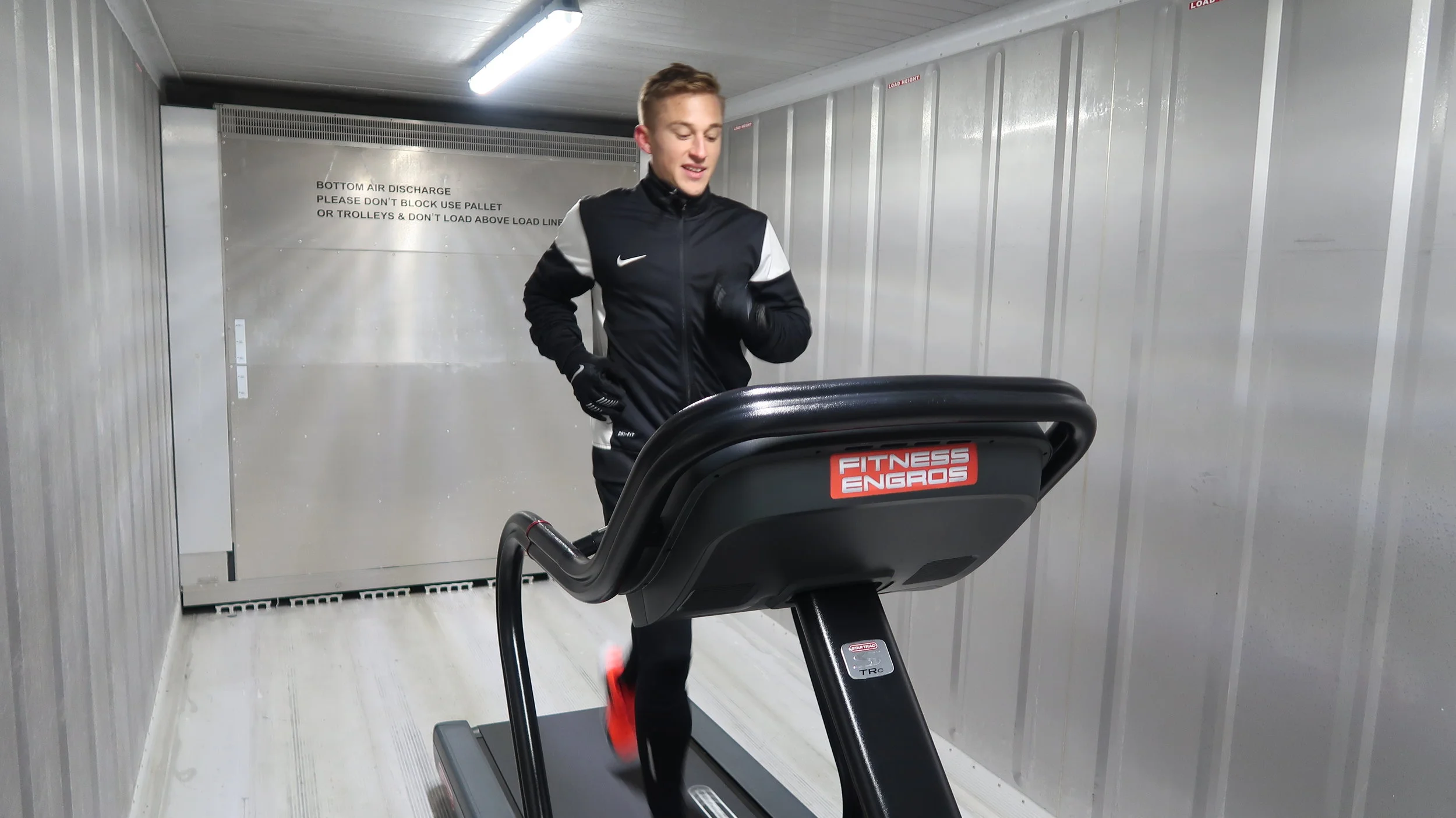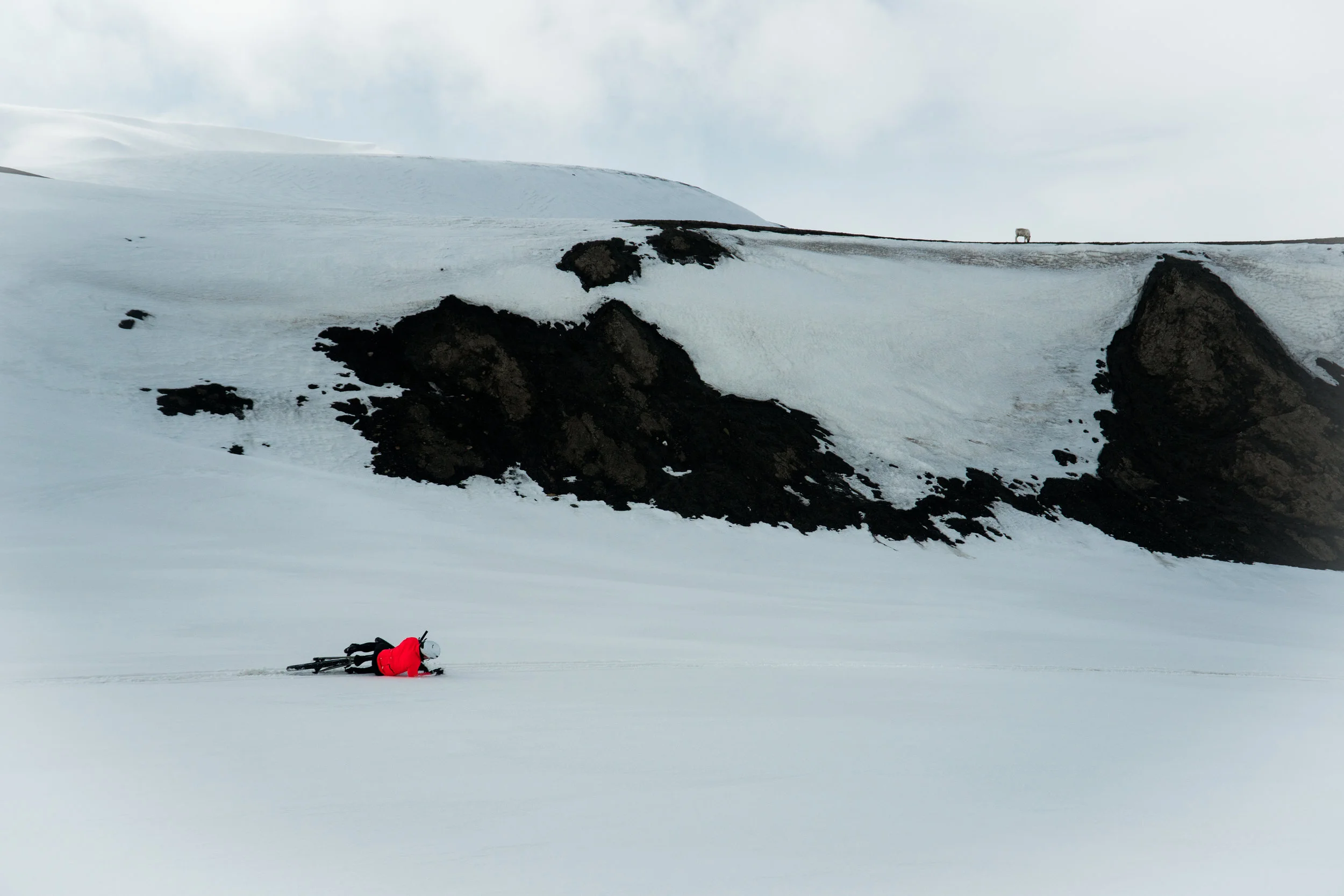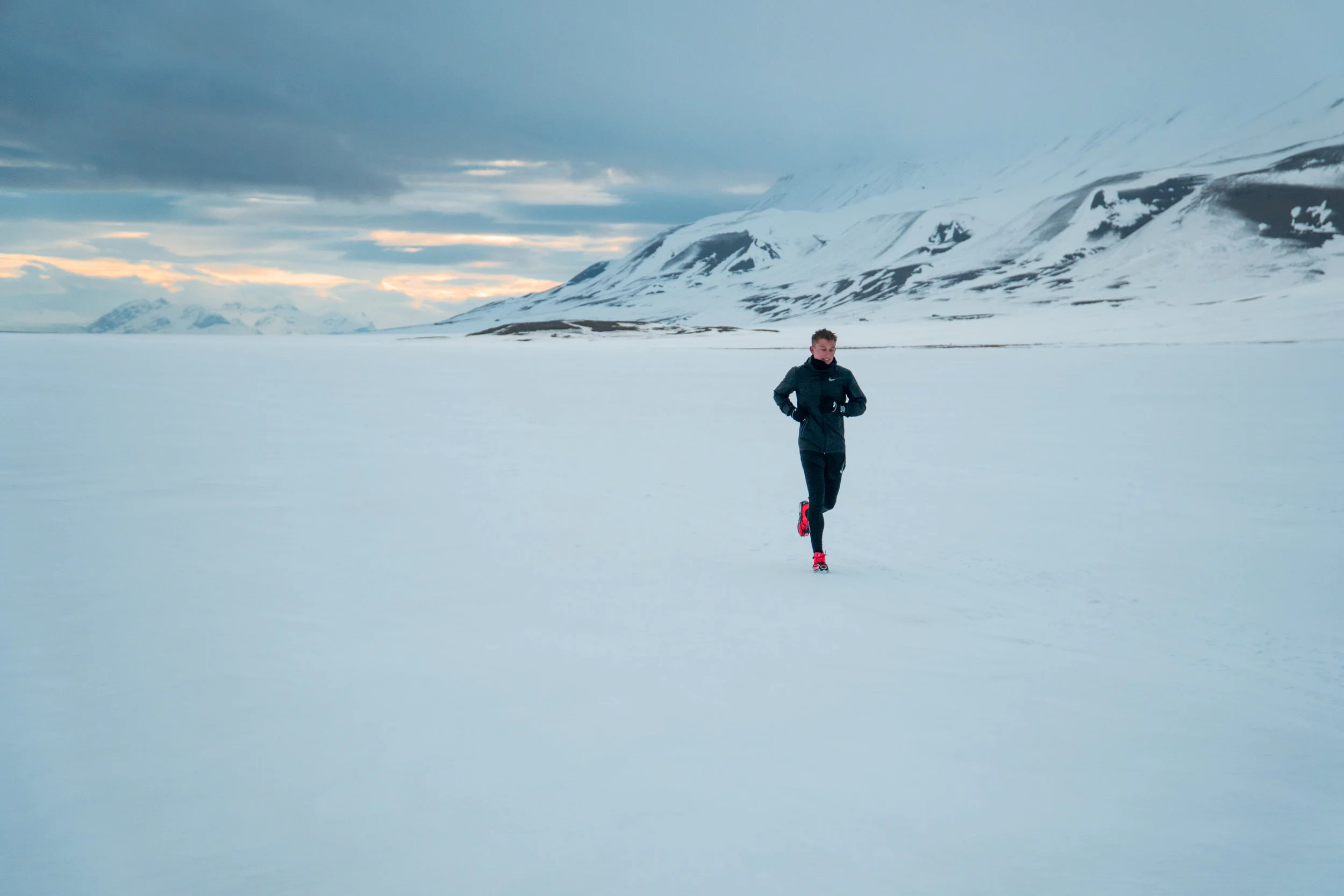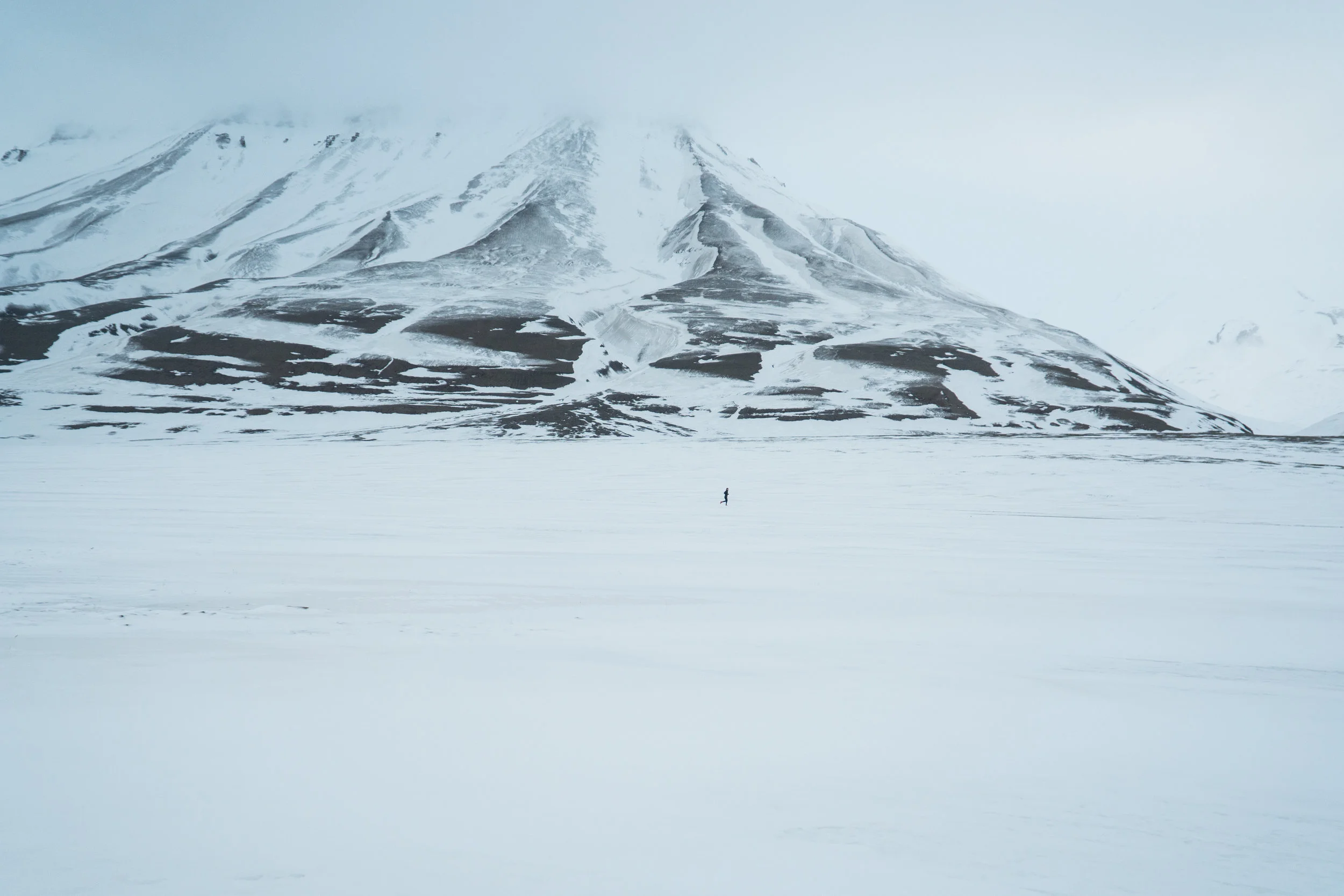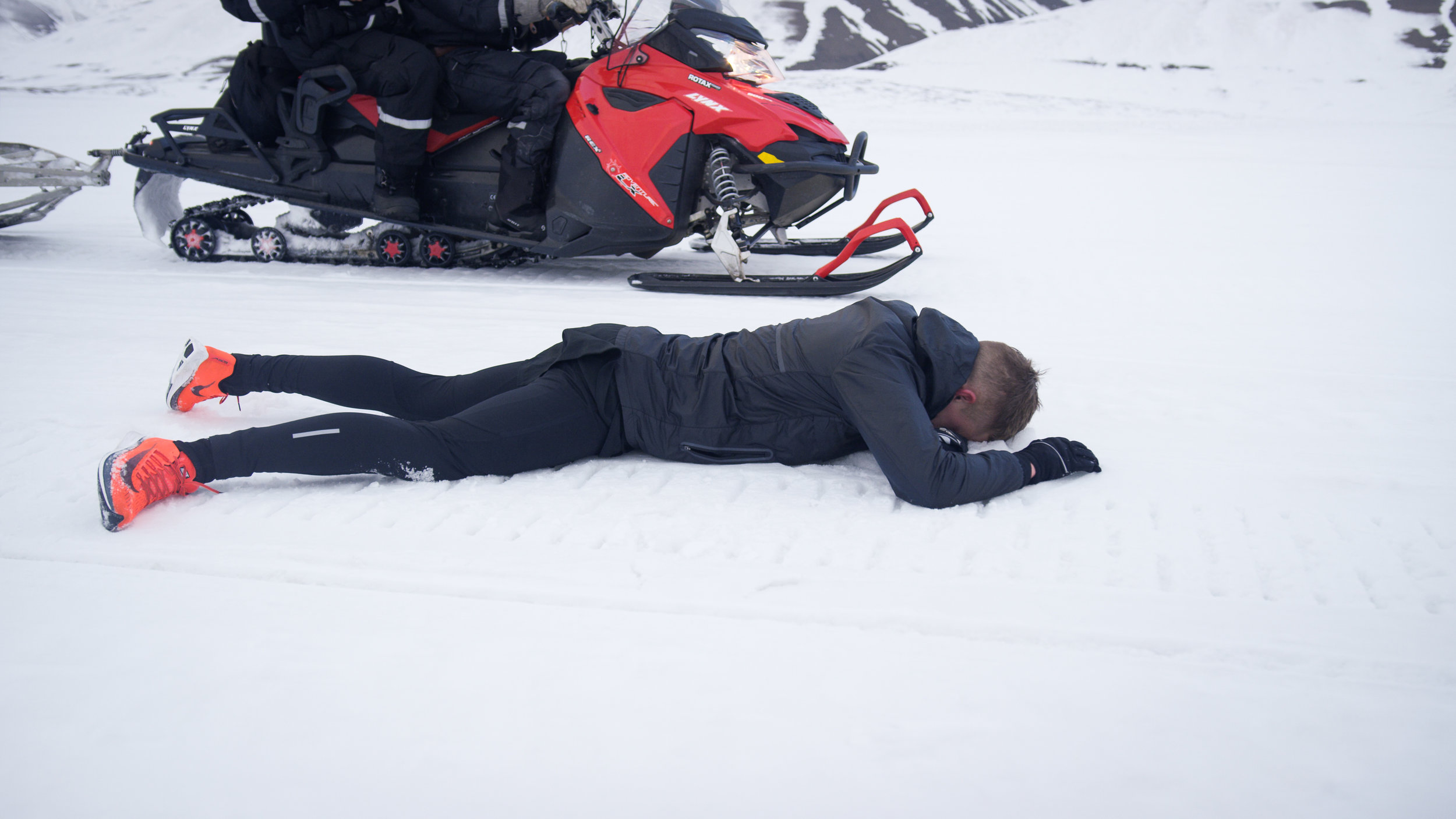LIMITLESS
Anders Hofman Laursen wants to be the first person in the world to complete an Ironman distance triathlon in Antarctica, the Iceman, set to happen in February 2020. In May 2019 he completed a half Iceman in Svalbard, Norway, breaking records with every stroke, spin and stride he took.
“There is no way, you can do that”.
It is probably one of the sentences 29-year-old Anders Hofman Laursen has heard the most since he decided to pursue the dream. A dream, that is hard not to smile and shake your head at. He wants to complete an Ironman distance triathlon in Antarctica.
Just the thought of the cold temperature and distance are enough for the rest of us to say: “No thank you,” and frown our eyebrows. You can even get Anders himself to smile about it. Maybe to be polite, because really, there is much seriousness behind Project Iceman.
The seriousness is not only linked to the physical challenge and danger it is to swim 3.9 kilometers through icy water, bike 180 kilometers in ankle deep snow and run a marathon on what is basically ice. There is also a seriousness in showing the rest of us – laughing nervously or shrugging our shoulders in disbelief – that you are able to do, whatever you want to do. Even if no one else has done it before.
Project Iceman is a story of breaking boundaries. A tale of becoming our own worst enemy or letting others dictate what is right or wrong. Project Iceman is about trusting your own dreams and believing that there are no limits to what you can achieve.
A belief Anders Hofman Laursen proved when he completed a half Iceman on Svalbard, Norway, on May 14th, 2019.
THE SWIM
The temperature is -2 degrees Celsius and the air is filled with snow, making it foggy and grey. Anders is about to take the biggest step yet in Project Iceman together with his team of four. They arrived yesterday in Longyearbyen, the capital of Svalbard and northernmost city in the world, only 1,000 kilometers from the North Pole.
The main location for the half Iceman is Adventdalen, a valley surrounded by mountains, stretching 35 kilometers long and three kilometers wide, where Anders has to bike and run. The valley leads out to Isfjorden, the second largest fjord in Norway. Here Anders is standing at the edge of the biggest step yet in Project Iceman, just waiting to get in the freezing water. Before him lies 1.9 kilometers of swimming.
The water temperature is zero degrees Celsius and the wind 14 m/s, enough to make waves break. Anders is excited. Excited to try for the first time, what he has gotten himself into.
Wearing a 5.5-millimeter wetsuit with a hoodie, diving googles, socks and gloves almost every inch of his body is covered in neoprene. Only his mouth is exposed. As he steps into the Isfjord he has Loup, his Svalbard-guide, and Jan, his photographer, in a kayak beside him.
The first thing the cold hits, besides his exposed bottom face, is his hands. It feels like the blood in the hands freezes, like when you try to grip on to something, but the fingers won’t bend. From there, the cold starts spreading gradually to each body part, and soon there isn’t one part colder than the other.
At the beginning of the swim the water is still clear, so Anders can see the bottom. As he gets into deeper and deeper water his vision disappears. There is only darkness and the limited vision in the foggy googles above the water. His hearing is also restricted as he has thick neoprene around his ears. He can only hear his own breathing and the quiet mumbling from Jan and Loup, not being able to make out what they are saying.
As he passes the first kilometer his watch freezes from the cold. He now only knows the time, not the distance. And this is where he started to get in trouble. From Jans point of view Anders is getting disorientated, zig-zagging from the deep water towards the shore and back again. Not being able to swim in a straight line.
The goggles start to push against Anders’ forehead. The cold plastic rim carves its way into his skin. It is the only thing Anders can think of. Like when you have an itch, you are not able to scratch. So, he takes it off, resulting in the mask not sealing probably. The water begins seeping into the googles, and Anders has to stop and correct the mask occasionally, exposing his forehead to the cold.
As the thick wetsuit is wearing on Anders’ shoulders, it makes each stroke harder. The thoughts going through Anders’ head is to activate his legs and fingers, so the cold is bearable. It is actually the only thing he can think about: The cold.
As he has to adjust the googles more often his back gets exposed and keeps getting colder. As does his forehead, giving him brain freezes. From now on Anders is just thinking about surviving and getting onto the shore. The waves in the water makes it hard for him not to shallow the ice-cold, salty water. Resulting in him choking, also forcing him to stop.
After 46:09 minutes Anders stumbles onto the shore.
“It was just freaking cold”, Anders mumbles.
The cold and the struggle of getting out of the wetsuit is all Anders can remember from the shore. He doesn’t remember the things he said or the surroundings. His lips and tongue were numb, making it hard for him to speak.
He starts to dress down in stages, starting at the top. As he removes the wetsuit from his back, his skin is purple. The crew watches Anders closely, worrying he could go into hypothermia. His face is white, and he is shaking uncontrollably.
As he changes, he becomes colder and colder, and the only thing he can think about is getting on the bike to generate some warmth. In a regular Ironman it takes a few minutes to change from swimwear to bikewear. It takes Anders 24 minutes. Everything is a challenge for his body, especially to put on socks and tights.
The team jumps on the snowmobile, leaving Anders alone on the bike. Jan and Loup has to change clothes as well, so the plan is to meet up with Anders, as soon as they can. Anders starts pedaling though the city, and as he enters the verge of Adventdalen the falling snow makes it impossible to see anything.
Will his crew be able to find him if he goes out into the white blur?
Mr. iceman
It might sound strange, but it is all about being ordinary for Anders. Even though there is nothing ordinary about Project Iceman.
He just turned 29 and completely changed his life a year and a half ago, when he decided to start the project. Anders looks like a businessman, with perfectly combed hair, but there is no doubt that he is strong, in excellent great shape, and would be able to outrun most people.
Although there is nothing normal about running in a container-sized freezer and lowering yourself into a barrel with ice, his training and diet are fairly ordinary. There is actually very little planning involved. He does the workout he feels his body can do, and he eats whatever he can afford. Not like most athletes. Which makes Anders a different breed of athlete. It is all about being ordinary and achieving the extraordinary.
“I don’t really have a big passion for triathlon,” Anders says with a grin. “Ironically enough”.
When Anders finished his master’s degree at Copenhagen Business School two years ago, he started a company creating personalized training-schedules based on data from your own smartwatch. The target-group was Ironman triathletes. So, Anders’ way into this adventure was led by a business plan. He completed his first Ironman in Copenhagen in 2016. And from there, the whole idea of Project Iceman began.
“Instead of looking in the same direction as everybody else, I wanted to do something that challenged the boundaries of the sport,” Anders says, on why he is not training to complete an Ironman on one of the other six continents.
Because his passion isn’t about triathlon it is about pushing his own physical and mental limits.
Back in January Anders pushed his own boundaries, when training his ability to stay submerged in icy-cold water. He jumped in the harbor outside The Opera house in Copenhagen. The first day he was able to stay in the water for 35 seconds. 7 days later he could endure 11 minutes. To him this has been one of the most eye-opening experiences, as the only thing that changed during those 7 days was his mindset.
“When you are doing something extreme, you really challenge yourself mentally,” Anders says, “And that is what makes it interesting”.
He continues to jump into a barrel filled with ice water as the ocean becomes warmer and warmer with the arrival of spring. There he just sits and focuses on his breathing, challenging his own limits.
This mentality also means that no one can tell Anders what he can or cannot do. Because how could they know? No one has ever attempted an Ironman in Antarctica before.
“I am not always motivated to do the project. But I am dedicated and I believe, that I am able to do what I want, if I work for it,” Anders says.
“Sometimes you feel like there is no purpose for any of it. But writing down the good and the bad helps. Especially what I am grateful for. I have to remind myself of the purpose of the project, and that keeps my eyes on the ball,” Anders says.
THE BIKE
Anders decides it is better to wait for the others before entering Adventdalen. Otherwise he would have no communication possibilities.
The windchill makes the temperature feel close to –10 degrees, and Anders has to get warm. Fast.
Even though it is very cold, the temperature is on the verge of being too warm for Project Iceman. Due to a pilot strike in April the trip was delayed almost three weeks, making the conditions challenging for Anders, as the snow is slushy.
The team arrives ten minutes later, and the bike ride can begin. Facing Anders is 90 kilometers in a terrain he knows nothing about.
As he starts pedaling everything makes sense to him. The project, the trip and all the training. His pace is good, and his body starts to get warm. So warm he takes one of his shirts off.
But as he continues further into the valley, the snow begins to get wetter. It splashes out on each side as the bike wheels plow through it. Anders is scared he might fall, so he grips hard on the bike handles. If he hits the ground, he’ll be soaked, and he has no extra clothes. His feet are already getting wet, as the slushy snow hits his shoes.
Anders does deliberately not look at the distance. He knows, he has been at it for quite some time, but he wants to get positively surprised. He knows he wasn’t going fast, but he knew that time-wise, he should be about halfway.
He shouts out to Jan on the scooter driving next to him asking how how fair he is in. Jan shouts back: “25”, without really thinking about the reaction to his answer, even though he can see how much Anders is struggling.
At that exact moment Anders mood changes. He thinks Jan is joking. The fear of the conditions demoralizes him. There is still 65 kilometers to go and the snow just kept getting deeper. Underneath the snow there is an icy layer, and the bike keeps sliding, resulting in him falling down on his side. Again and again.
The pace is slow, and in Anders’ head, the focus becomes completing just one kilometer at a time. He wants to stop, but as long as he is able to stand, he will continue.
Stubbornly, he keeps pedaling. The snow gets deeper. After 42,5 kilometers it is impossible for Anders to get onto the bike because of 40-centimeter-deep snow. The conditions are simply too inaccessible, so Anders starts going back from where he came from. However, it’s now going slightly uphill and he is facing a 20 m/s headwind.
Combined with the deep snow it is nearly impossible to move forward and after 47,5 kilometers Andes gets to a place, where it’s impossible to bike. He can’t even get up on the bike without falling. The team has to make a harsh decision: Head back to starting point to finish the rest of the race.
Anders gets on the sled carried by one of the snowmobiles. The pause is not great for him, and the motivation gets lower. 45 minutes later the setback, he is back on the bike. Back at the starting point. The bike ride doesn’t feel like the first time he was there. He has no more energy.
The team set up a camp at the starting point and Anders cycles around in loops all by himself. He only focuses on moving forward, and the nature and landscape disapperars, even the reason for Project Iceman fades.
After seven hours and three minutes Anders has completed two thirds of the half Iceman.
He gets in to the snowmobile to change his clothes to running tights and shoes. He loads up on some energy gel and dry crackers and then he is ready to take on the last leg of the half Iceman.
perceptions
Back in Copenhagen Anders’ days evolves around Project Iceman. In between the workouts he has to find funding, do social media, plan trips and deal with a variety of issues.
The swim on Svalbard taught Anders that he has to learn how to correct the mask, practice wearing it for longer periods of time. He also has to figure out how his watch can tolerate the cold, as well as what to do if a leopard seal decides to join him in Antarctica. And those are only regarding the swimming part.
The preparations of the project is basically on Anders’ mind 24/7.
“When you set out to do something no one else has done, you are often met with skepticism,” Anders says. To him the disbelieve of others is what drives him in Project Iceman.
“I am tired of others telling people what they can or cannot do, especially, when they have no foundation for saying it. Other people often impose their own reality upon others, and we are not taught to be critical of the input we get from other people”.
When Anders was younger, he dreamed of becoming a professional footballer, then he wanted to open his own business, but he never dove head first into any of it. He didn’t feel confident or supported enough, which meant he postponed or never did the things he truly felt he desired.
“I went the ordinary way, going through high school trying to get the best grades, so I could start studying International Business, only to do what many other people did. I was walking around blind, not doing the things I really wanted, because the things I really had wanted to do were not realistic in the eyes of the people around me.”
Even though this could seem like Anders is blaming others for his own choices, that is not what he means. He has no doubt, that the people around wanted the best for him and has supported him in the way they felt best. But he realized that he was driven by grades, a prestigious job and norms instead of his own passion and nature.
Only to get to the point, where he didn’t get the prestigious jobs he and everyone else had been aiming for.
It is all about believing in our own abilities, not being held down by our own or other’s perceptions.
THE RUN
Anders’ knees are sore, and his legs tired after the bike ride. But he is getting his positive mindset back. Now he only has running left. The discipline he feels most confident in. By now, he has been at the race for almost nine hours.
The first four kilometers goes alright. He is running up through a valley and the snow is about 20-30-centimeter-deep. He has attached spikes to his running-shoes so he won’t slip. But soon his pace starts slowing down. It drops from five minutes to more than seven minutes per kilometer.
The snow makes the running harder, as Anders doesn’t know if his feet will go through the snow or not. He has to flex the muscles in his ankles at all times, in order not to twist them and fall completely. Just like when you are running in sand.
As he hits the eight-kilometer mark his energy disappears. The only thing Anders wants to do is stop and walk.
His legs are done, but there is no doubt in Anders’ mind that he can finish, it is just a question of the manner. Running or walking.
In his mind he attempts to compare it to another psychical challenge he has encountered to mentally help himself. But there is nothing that measures to what he is going through right now.
He breaks the remaining distance into 250 meter increments, making them goals in themselves, in order to keep going. Around him is nothing but the towering black mountains and endless stretches of snow. He keeps running as much as he can, trying not to slow to a walk.
Anders finishes the run in two hours and 22 minutes, and the relief is clear when Anders collapses on the snowy ground. There is just no energy left in him. The team all embraces him, also tired and worn out. They are also relieved that he made it.
After 10 hours and 52 minutes Anders completes the half Iceman - having done what nobody else has done before him. The northernmost traithlon ever completed.
As the team heads back to Longyearbyen, everything is closed. The only food Anders can get is a freeze-dried spaghetti from a bag he bought the night before. But he is not really hungry or thirsty. He isn’t sleepy either. There is still so much adrenalin pumping around in his body, making it tingle everywhere. His face is burning from all the cold wind endured all day and he has a light sunburn from the sun’s reflection in the snow.
The biggest challenge in Project Iceman to date was a success. Two days later, the team is heading back to Copenhagen.
AntarCtica
On the flight home Anders was already thinking about the next step in the project: Antarctica. There, the challenge is double the distance in a much harsher environment.
“It is hard to grasp the experience. So much happed in three days”, Anders says about Svalbard. He adds that it still feels like a dream: The nature, the support, and the fact that he did it. He hasn’t really processed it yet, especially the fact that he is the first person ever to complete a triathlon at that latitude.
After Svalbard he met with Phil, an Antarctic-guide, to start planning the trip. If everything goes as planned, the trip will take place in February 2020. That time a year, there is only two entry-points to the shore in Antarctica, and that is only if the weather conditions allow it.
The team will fly from Denmark to Argentina, and from there, it is a three to five days boat ride to get to Antarctica, plus another two to three days to reach the points of entry. Getting to the shore in itself is a big challenge, and a crucial part of the project succeeding. Here Anders will need all the luck he can get.
If the team is able to get to shore, there are not a lot of possibilities for routes. There are ice cracks up to 50 meters deep in the terrain. Therefore, Anders will need Phil along on the trip, so he can spot the most dangerous places, as they also can be covered with snow, making them treacherously hard to see.
The environment is truly uninviting, which also means that it will probably be the same 10-kilometer route Anders will have to bike and run in loops.
“Svalbard was a wakeup call on how much this takes and how different it is from everything else. It isn’t just something you can do from one day to another. I never expected it to be this challenging, when I started the project,” Anders says.
The bike ride on Svalbard was very challenging to Anders, and the thought of running a marathon afterwards in Antarctica is a bit intimidating. He will probably have to run in the dark, as it is expected that the Iceman will take between 16 to 24 hours.
Anders keeps believing in the project, even though it has become a greater challenge, than he ever expected. The planning, economics and training are all equally important for the project to succeed. From here on out he has to amp up the training like running in sand and with a weighted west, being in cold water and getting in longer distances.
But as Jan puts it: “It is going to take more than ice, freezing degrees and leopard seals to stop the Iceman”.
Text by Amalie Pind
Photos: Jan Laumark og Nicklas Kold Nagel







